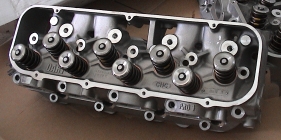|
Two-Stroke Porting
In addition to all the considerations given to a four-stroke engine port, two-stroke engine ports have still more to consider:
Scavenging quality/purity: The ports are responsible for sweeping as much exhaust out of the cylinder as possible and refilling it with as much fresh mixture as possible. This takes careful and subtle aiming of all the transfer ports.
Power band width:Since two-strokes are very dependent on wave dynamics, their power bands tend to be narrow. While struggling to get maximum power, care must always be taken to ensure that the power profile does not get too peaky and hard to control.
Time area: Two-stroke port duration is often expressed as a function of time/area. This integrates the continually changing open port area with the duration. Wider ports increase time/area without increasing duration while higher ports increase both.
Timing: In addition to time area, the relationship between all the port timings strongly determine the power characteristics of the engine.
Wave Dynamic considerations: Although four-strokes have this problem, two-strokes rely much more heavily on wave action in the intake and exhaust systems. The two-stroke port design has strong effects on the wave timing and strength.
Heat flow: The flow of heat in the engine is heavily dependent on the porting layout. Cooling passages must be routed around ports. Every effort must be made to keep the incoming charge from heating up but at the same time many parts are cooled primarily by that incoming fuel/air mixture. When ports take up too much space on the cylinder wall, the ability of the piston to transfer its heat through the walls to the coolant is hampered. As ports get more radical, some areas of the cylinder get thinner which can then overheat.
Piston ring durability: A piston ring must ride on the cylinder wall smoothly with good contact to avoid mechanical stress and to cool the piston. In radical port designs the ring barely touches anywhere at all in the lower stroke area. These areas can suffer extra wear due to the minimal contact and the mechanical shocks during transition from partial to full cylinder contact shorten the life of the ring considerably. Very wide ports allow the ring to bulge out into the port, exacerbating the problem.
Piston skirt durability: The piston must also contact the wall for cooling purposes but also must transfer the side thrust of the power stroke. Ports must be designed so that the piston can transfer these forces and heat to the cylinder wall while minimizing flex and shock to the piston.
Engine configuration: Engine configuration can be influenced by port design. This is primarily a factor in multi-cylinder engines. Engine width can be excessive for even two cylinder engines of certain designs. Rotary disk valve engines with wide sweeping transfers can be so wide as to be impractical as a parallel twin. The V-twin and fore-and-aft engine designs are used to control overall width.
Cylinder distortion: Engine sealing ability, cylinder, piston and piston ring life all depend on reliable contact between cylinder and piston/piston ring. Cylinder distortion reduces power and engine life. This distortion can be cause by uneven heating, local cylinder weakness or mechanical stresses. Exhaust ports that have long passages in the cylinder casting input lots of heat on one side of the cylinder while on the other side the cool intake may be cooling the opposite side. The thermal distortion resulting from the uneven expansion reduces both power and durability. Careful design can minimize the problem.
Combustion turbulence: The turbulence remaining in the cylinder after transfer persists into the combustion phase to help burning speed. Unfortunately good scavenging flow is slower and less turbulent.
Porting methods
The die grinder is the stock and trade of the head porter. They are used with a variety of carbide cutters, grinding wheels and abrasive cartridges. The complex and sensitive shapes required in porting necessitate a good degree of artistic skill with a hand tool.
In addition, CNC machining is used to provide the basic shape of the port but hand finishing is usually still required because some areas of the port are not accessible to a CNC tool and the desired surface finish may not be possible with CNC alone. CNC milling can eliminate the tedious job of removing the bulk of unneeded material, leaving only the final finishing for hand tools, as well as providing much needed and accurate reference points for that same hand finishing, greatly speeding the job.
Measurement of the interior of the ports is difficult but must be done accurately. Sheet metal templates are made up, taking the shape from an experimental port, for both cross-sectional and lengthwise shape. Inserted in the port these templates are then used as a guide for shaping the final port. Even a slight error might cause a loss in flow, so measurement must be as accurate as possible.
Summary
The internal aerodynamics involved in porting is counterintuitive and complex and absolutely requires an air flow bench, a thorough knowledge of the principals and use of engine simulation software in order to determine what needs to be done to optimize a port.
Although a large portion of porting knowledge has been accumulated by individuals using cut and try methods over time, the tools and knowledge now exists to develop a porting design with a measure of certainty. Porting “willi nilli” without full understanding still continues but the results are spotty and the process is expensive and time consuming with many more failures than successes.

|